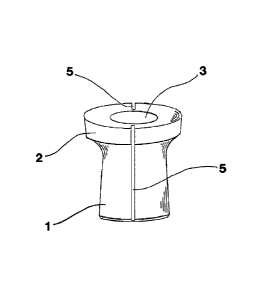Some of the information on this Web page has been provided by external sources. The Government of Canada is not responsible for the accuracy, reliability or currency of the information supplied by external sources. Users wishing to rely upon this information should consult directly with the source of the information. Content provided by external sources is not subject to official languages, privacy and accessibility requirements.
Any discrepancies in the text and image of the Claims and Abstract are due to differing posting times. Text of the Claims and Abstract are posted:
| (12) Patent: | (11) CA 2986130 |
|---|---|
| (54) English Title: | MORSE TAPER PROTECTIVE SLEEVE |
| (54) French Title: | MANCHON PROTECTEUR DE CONE MORSE |
| Status: | Granted |
| (51) International Patent Classification (IPC): |
|
|---|---|
| (72) Inventors : |
|
| (73) Owners : |
|
| (71) Applicants : |
|
| (74) Agent: | DEETH WILLIAMS WALL LLP |
| (74) Associate agent: | |
| (45) Issued: | 2018-10-16 |
| (86) PCT Filing Date: | 2016-06-06 |
| (87) Open to Public Inspection: | 2016-12-15 |
| Examination requested: | 2018-02-09 |
| Availability of licence: | N/A |
| (25) Language of filing: | English |
| Patent Cooperation Treaty (PCT): | Yes |
|---|---|
| (86) PCT Filing Number: | PCT/US2016/036040 |
| (87) International Publication Number: | WO2016/200735 |
| (85) National Entry: | 2017-11-15 |
| (30) Application Priority Data: | ||||||
|---|---|---|---|---|---|---|
|
A removable orthopedic protective sleeve adapted to be applied over the male Morse taper of modular orthopedic implants thereby preventing contamination of the taper contact surface from blood, body fluid or tissue particles responsible for electrochemical corrosion and fretting at the level of Morse taper. Said sleeve having a conical tube shape and a rim at is upper narrow end. A plurality of vertical grooves situated on the outer surface of the protective sleeve will split open as the female Morse taper is slidingly flushed downward and seated over the male taper. The split sleeve is then removed after the male and female tapers are assembled in-situ.
La présente invention concerne un manchon de protection orthopédique amovible adapté pour être appliqué sur le cône Morse mâle d'implants orthopédiques modulaires de manière à prévenir la contamination de la surface de contact du cône par du sang, un fluide corporel ou des particules de tissu responsables de la corrosion électrochimique et de l'usure au niveau du cône Morse. Ledit manchon présente une forme de tube conique et un rebord à son extrémité étroite supérieure. Une pluralité de rainures verticales situées sur la surface externe du manchon protecteur se fendent de façon ouverte lorsque le cône Morse femelle est mis en butée par coulissement vers le bas et installé sur le cône mâle. Le manchon fendu est ensuite retiré une fois que les cônes mâle et femelle sont assemblés in situ.
Note: Claims are shown in the official language in which they were submitted.
Note: Descriptions are shown in the official language in which they were submitted.

For a clearer understanding of the status of the application/patent presented on this page, the site Disclaimer , as well as the definitions for Patent , Administrative Status , Maintenance Fee and Payment History should be consulted.
| Title | Date |
|---|---|
| Forecasted Issue Date | 2018-10-16 |
| (86) PCT Filing Date | 2016-06-06 |
| (87) PCT Publication Date | 2016-12-15 |
| (85) National Entry | 2017-11-15 |
| Examination Requested | 2018-02-09 |
| (45) Issued | 2018-10-16 |
There is no abandonment history.
Last Payment of $210.51 was received on 2023-05-31
Upcoming maintenance fee amounts
| Description | Date | Amount |
|---|---|---|
| Next Payment if small entity fee | 2024-06-06 | $100.00 |
| Next Payment if standard fee | 2024-06-06 | $277.00 |
Note : If the full payment has not been received on or before the date indicated, a further fee may be required which may be one of the following
Patent fees are adjusted on the 1st of January every year. The amounts above are the current amounts if received by December 31 of the current year.
Please refer to the CIPO
Patent Fees
web page to see all current fee amounts.
| Fee Type | Anniversary Year | Due Date | Amount Paid | Paid Date |
|---|---|---|---|---|
| Registration of a document - section 124 | $100.00 | 2017-11-15 | ||
| Application Fee | $400.00 | 2017-11-15 | ||
| Request for Examination | $800.00 | 2018-02-09 | ||
| Maintenance Fee - Application - New Act | 2 | 2018-06-06 | $100.00 | 2018-06-04 |
| Final Fee | $300.00 | 2018-09-04 | ||
| Maintenance Fee - Patent - New Act | 3 | 2019-06-06 | $100.00 | 2019-05-15 |
| Maintenance Fee - Patent - New Act | 4 | 2020-06-08 | $100.00 | 2020-05-13 |
| Maintenance Fee - Patent - New Act | 5 | 2021-06-07 | $204.00 | 2021-05-12 |
| Maintenance Fee - Patent - New Act | 6 | 2022-06-06 | $203.59 | 2022-04-13 |
| Maintenance Fee - Patent - New Act | 7 | 2023-06-06 | $210.51 | 2023-05-31 |
Note: Records showing the ownership history in alphabetical order.
| Current Owners on Record |
|---|
| JOINT INNOVATION TECHNOLOGY, LLC |
| Past Owners on Record |
|---|
| TERMANINI, ZAFER |